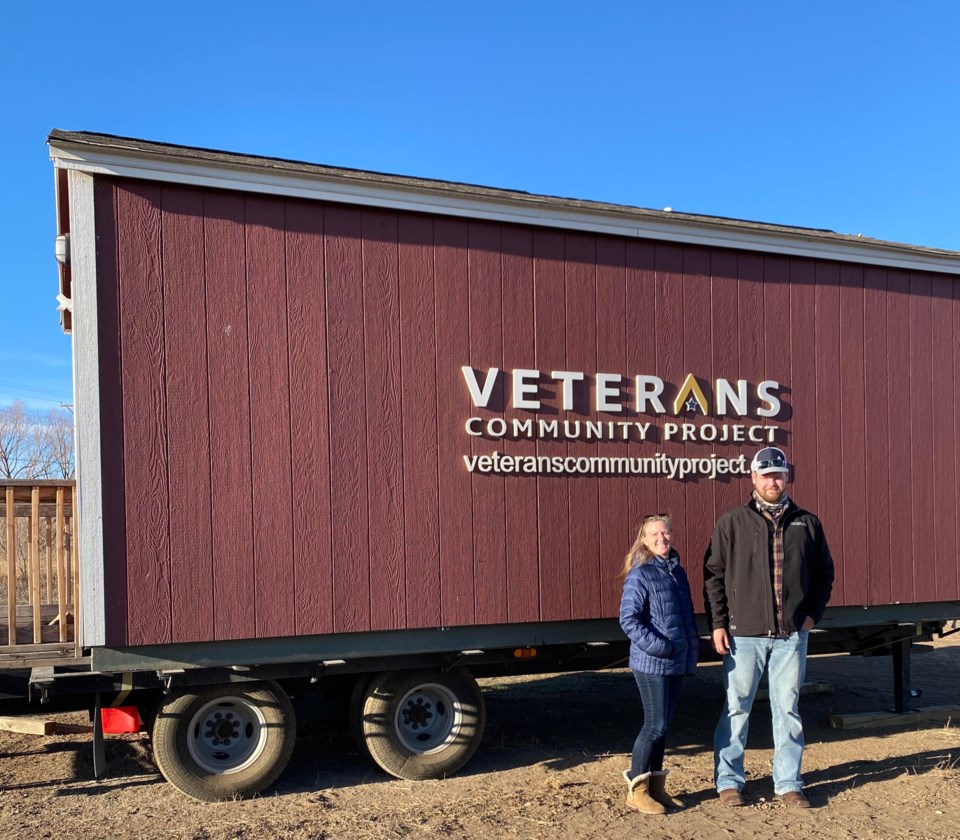A tiny home community aimed at providing stable housing to homeless veterans is months away from completion in Longmont, but the organization behind it is already finding a way to make a difference locally.
“We’ve housed six veterans in permanent housing in the past six months,” said Sean Anderson, director of veterans support services for Kansas City-based Veterans Community Project, which is launching its national expansion with the Longmont Veterans Village.
The nonprofit also has provided 64 nights of emergency hotel stays and $11,000 in emergency assistance funding, which Anderson said is not “Band-Aid funding” but rather is enough to give veterans the tools to reclaim their housing, to get into housing, to pay off utilities or to avoid eviction.
“We’re doing a lot … for a two-person staff,” he said.
The second person is Cammy Cadwell, who joined VCP this fall after previously working as a shelter manager at HOPE for Longmont.
Together they are a street outreach team doing most of their work from a truck — or anywhere they can.
“We decided with everyone going virtual, it was important for us to do things in the field. Things get lost in the mix online and on the phone,” Anderson said. “We’re serving veterans from Broomfield to the Northern Colorado border, putting a lot of miles on our vehicles.”
Cadwell said such outreach is important as the arrival of winter and the ongoing coronavirus pandemic exacerbate the need to keep people off the streets.
A lot of veterans avoid shelter environments, she said: “One, they don’t like to be around a lot of people or crowds. Another part is the pandemic, they don't want to be exposed (to COVID).”
Anderson said VCP is working with a lot of medically vulnerable veterans who wouldn’t do well in a shelter setting. “Forget about PTSD, we’re just talking COVID.”
Human service and veterans service organizations, such as Department of Veterans Affairs networks in Denver and Cheyenne, have helped connect veterans with the VCP duo, but Cadwell said their primary focus remains on connecting in the community and on the streets.
Anderson said, “We’re clawing our way to our guys any way we can. There are a lot of social workers working from home right now, rightfully so. We’re trying to be the on-the-ground unit, filling gaps.”
It all comes down to human connection, he said.
Having served roughly 40 veterans at this point, Anderson said there are many more who he and Cadwell aim to reach.
“The Point in Time Count ID’d about 50 homeless veterans in Boulder County last year,” Anderson said.
The Point in Time Count “is an unduplicated count of people experiencing literal homelessness on a single night in January,” according to the Metro Denver Homeless Initiative. “HUD defines literal homelessness as living in places not meant for habitation, shelter and some transitional housing programs. Persons at risk of becoming homeless (such as those staying with friends/family or paying to stay in a motel) are not included in this count.”
The typical guidance is to extrapolate the Point in Time number two to three times to get a truer picture of the number of homeless, so it’s likely there are at least 150 homeless vets in the county, Anderson said.
COVID has likely landed more people on the street, he said. And some of those people might not be served elsewhere.
“The thing about us is we will serve any veteran, regardless of discharge status or time served,” Anderson said, adding he and Cadwell are having conversations with local veterans “letting them know they deserve the same services. Most veterans are excited to see us. We’re finding a lot of veterans who are ready for help.”
Cadwell, a veteran who served in the Air Force, said they have encountered some stubbornness from vets, but “when people get to a certain point they know they need help.”
Establishing trust is key to overcoming pride that might prevent vets from seeking help, as is camaraderie among those who have served.
The oath members of the military take at the beginning of their service creates a bond, she said: “It’s your family essentially when you sign that paper. That’s for life.”
Anderson, who is not a veteran, said he is driven by his desire to support friends, families and strangers who served. When he is on the streets connecting with veterans who ask him why he’s there, his response is “I’m a damn good social worker and I want to help you.”
Want to get involved?
Fundraising is ongoing for the Veterans Community Project’s Longmont Village, which will feature 26 tiny houses and a 3,000-square foot community center. When construction gets underway at the site off Nelson Road to the west of Home Depot and Target — likely in the spring — volunteers will be needed to help build the homes that will range in size from 240 to 340 square feet. Learn more about how to donate or get involved, here.



